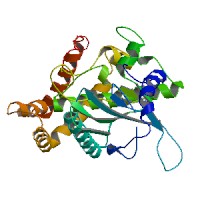The phosphotidylinositol 4-kinases (PI 4-kinases) generate phosphotidyl-4-phosphate (PI(4)P) from phosphotylinositol. PI(4)P is an important precursor for other phosphoinositides involved in signaling, such as PI(4,5)P2, which is the substrate of phospholipase C (PLC) and the precursor of DAG and insitol (1,4,5) triphosphate.
There are four different mammalian PI 4-kinases currently described, and these have been divided into two classes based on their sensitivities to wortmannin and adenosine. Type II PI 4-kinases (PI4K2A and PI4K2B) are not sensitive to wortmannin, but are inhibited by the nonspecific inhibitor adenosine; Type III PI 4-kinases (PI4KA and PI4KB) are sensitive to wortmannin.
The functions of the PI 4-kinases and their products are not fully understood. At least one study has shown that PI 4-kinases are important for the proper recycling of synaptic vesicles. The PI 4-kinase from Drosophila, four-wheel drive, is critical for contractile ring formation during cytokinesis. Other studies in yeasts and mammals have shown that PI 4-kinases localize to the Golgi, and in mammals might be critical for proper budding of vesicles from the Golgi. Additionally, type III PI 4-kinases appear to play a role in the replication of hepatitis C virus (HCV) and enteroviruses by participating in the formation of altered host membrane structures. Although, we have hints about their function, to really understand and dissect the precise roles of PI 4-kinases in cells, new tools, such as specific small-molecule inhibitors are required.
Continue reading “Identifying and Profiling Inhibitors for PI 4-Kinases Using a Luminescent High-Throughput Screen”
